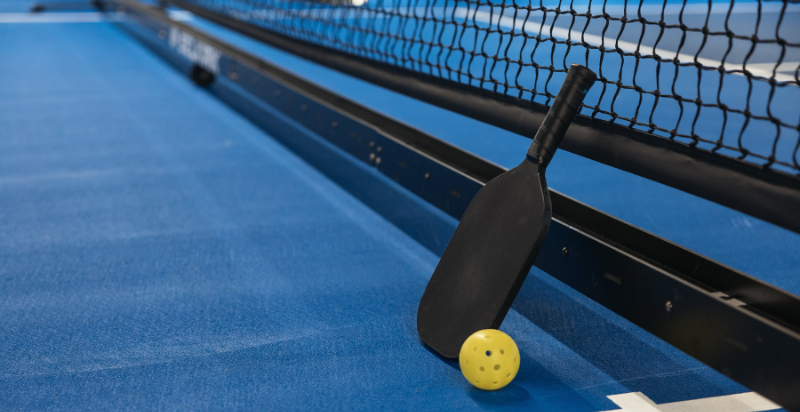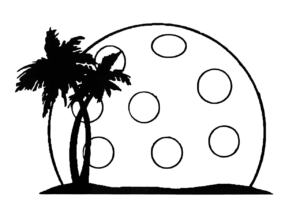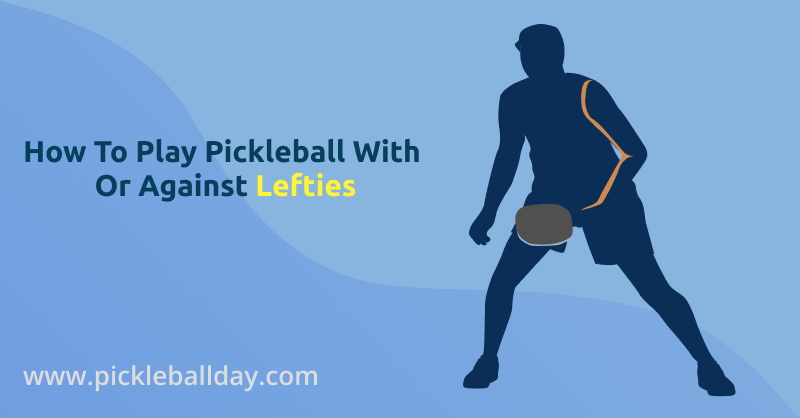So, you have to play with or against left-handed pickleball players frequently, and being right-handed, you often feel it’s hard to adjust and win. Well, while looking for some good strategies, you are in the right place. This article will lead you to how to change your tactics a little in the game.
Although your shots’ precision, pace, and flight are pegged to many factors, including your proficiency and the material of the pickleball paddle, your pickleball paddle grip plays a key role.
There isn’t a significant variation on whether you use a left-handed pickleball paddle or a right-handed one.
Your grip dictates the angle of your paddle, impacting and driving the ball. The grip variations greatly depend on your dominant hand (forehand shots) and weak hand (backhand shots). The difference between the left-handed pickleball paddle and the right one isn’t in the design but in a person’s ability to use either hand.
So stick around to understand how to grip a pickleball paddle in your left hand if you’re a leftie. In addition, you must learn how to accommodate a left-handed player as a partner and how to play against a left-handed pickleball player.

Table of Contents
- 1 What is a left-handed pickleball paddle?
- 2 Do you need a left-handed pickleball paddle?
- 3 How do you play pickleball if you are left-handed?
- 4 What are the advantages of playing left-handed pickleball?
- 5 What Are the Disadvantages of playing left-handed pickleball
- 6 Can you switch hands in pickleball?
- 7 What does switching mean in pickleball?
- 8 Why do pickleball players switch their hands?
- 9 What are the advantages of using both hands in pickleball?
- 10 Can pickleball players use both hands in a single point?
- 11 Expert tips for left-handers
- 12 How to play with a lefty partner
- 13 How to play against a lefty opponent
- 14 FAQs
- 15 Final Verdicts
What is a left-handed pickleball paddle?
A left-handed pickleball paddle is designed to offer comfort to leftie players and not leave them disadvantaged by right-handed pickleball players. Although the design, material, weight, and surface materials are similar, the spiral grip is designed to match the angles of the fingers of a left-handed player.
Do you need a left-handed pickleball paddle?
Not necessarily, because generally, the structure of the paddle grip is not designed with a particular physical capability or limitations in mind. Remember, when you are lefty and choose a pickleball paddle, you need not be more cautious about choosing a specialized paddle for left-handed players. As I said earlier, there are no exclusive differences between the paddles except the gripping direction is reversed from the right.
However, to outshine their competitors, some manufacturers make specific characteristics of the pickleball paddle to make them efficient and comfortable for either a leftie or a righty.
Given the likelihood of the pickleball falling in instances where you receive a powerful shot, they’ve designed spiral grips with finger placement on the paddle handle. Players can use other pickleball paddle grip techniques to ensure they play with any pickleball paddle without specifying hand dominance.
How do you play pickleball if you are left-handed?
Just like a right-handed player, there are no limitations or unique guides on how to play as a left-handed pickleball player. However, as a beginner looking for an easy-to-use grip that favors both the forehand and the backhand, the continental grip is ideal.
The octagonal shape of the pickleball handle dictates the placement of your fingers for a better grip and angle of the pickleball paddle. The eight sides of the paddle handle, known as bevels, are vital in identifying how to place the grip on the pickleball paddle correctly.
Hold the paddle in front of your body; the top bevel on the handle is labeled as number one. As a left-handed pickleball player, instead of counting clockwise, you’ll go anticlockwise.
The easiest way to grip the paddle is to assume you’re holding a hammer or hitting a nail; that is the exact grip to use on the pickleball paddle with the edge of the paddle. That’s why it’s referred to as the hammer grip.
Consequently, holding the paddle on the edge, you’ll conclude that the letter V formed by your thumb and index finger is on top of the paddle handle. And the big knuckle formed as you hold the paddle will rest on the second angle.
Different grips are suitable for backhand drives, forehand drives, topspin, drop shots, slices, long shots, resets, etc. Moreover, the continental grip is a neutral one, enabling you to enjoy playing pickleball as you transition to other grips suitable for you.
What are the advantages of playing left-handed pickleball?
1. Being a lefty gives you a clear view of your opponent as your body is square to the net. A backhand stroke limits that by leaving you exposed to the trickery of your opponents, who have to turn your head so you can hit the ball.
2. It’s easier for players with racquet experience as they can easily interchange between the dominant and weak hands effortlessly.
3. It plays to your advantage, showing you have a strong forehand and backhand, leaving the opponent confused about where to place the ball.
4. Offers players with limited mobility to get additional reach by switching hands.
What Are the Disadvantages of playing left-handed pickleball
1. A high percentage of dropping the paddle as you switch hands.
2. It’s hard to switch while engaging in the kitchen line exchange; this limits the switching to bouncing balls.
3. You’ve got to be efficient at this, as it isn’t easy to use your weak hand.
Can you switch hands in pickleball?
Yes, you can switch hands in pickleball. While it is more common for players to have a dominant hand, we say them righty or lefty and use it throughout the game. In a fast game like pickleball, always there are situations where players choose to switch hands for strategic or convenience reasons.
What does switching mean in pickleball?
Switching hands in pickleball means that you would change the hand you hold the paddle with, typically from your dominant hand to your non-dominant hand or vice versa. Picklers choose this during a point or between points, depending on the player’s preference and the specific situation.
Why do pickleball players switch their hands?
Many pickleball pros play left and right-handed. Some players may switch hands to improve their reach or to get a better angle on the ball. For example, if a shot is on the opposite side of your body, using your non-dominant hand might give you a better chance of reaching it. Additionally, players may switch hands to change their grip style or to adapt to a particular shot or opponent.
Switching hands requires practice and coordination, as it can affect your control and shot quality. It’s important to note that not all players choose to switch hands, and it’s not a requirement in pickleball. I would rather say that it’s a personal choice that depends on individual playing styles and preferences.
What are the advantages of using both hands in pickleball?
Using both hands can provide certain advantages. Usually, players use it for better reach and increased control over the shot. Some players may choose to switch hands during a rally or use both hands simultaneously for specific shots, such as a two-handed backhand.
However, switching between the right and left hand is not always recommended as using both hands simultaneously can reduce your ability to quickly switch directions or react to unexpected shots. You need to practice and develop coordination when using both hands in pickleball to ensure you maintain good control and positioning on the court.
Can pickleball players use both hands in a single point?
In pickleball, the official rules do not prohibit a player from using both hands during a single point or rally. But you must remember the certain restrictions on hitting the ball twice in a row. Players are not allowed to hit the ball twice consecutively unless it has rebounded off the net or the opponent’s paddle.
So, while you can use both hands to hit the ball in a single point, you cannot hit it twice in a row with the same hand, unless it has made contact with the net or your opponent’s paddle in between.
Expert tips for left-handers
Playing as a left-hander comes with a lot of fear, given the right-handed players’ reluctance and resistance to playing pickleball with a left-handed partner. So if you’re paired with a right-handed person, here are a few tips to keep in mind for a successful game.
Identify the Forehand and Backhand
Your partner and opponent’s strong and weak arms are critical and determine the strategies to implement to win points. During every rally, where do they place them, and where should you and your partner position yourselves?
Left-Right Communication
While you play in a left-right combination, it’s important to communicate beforehand to determine who has a strong forehand and backhand. These tactics will dictate your side on the pickleball court. Having established that, decide who takes the middle shots as it confuses players during the game, and opponents utilize this strategy to emerge as winners.
Hit Cross-court
Ensure you hit the ball cross-court to the opponent in front of your partner, making it harder for the opponent to take an offensive shot. The only possible shot is to hit one of you because making a cross-court dink would be difficult. Hitting the ball on the backhand side will make it even harder for the opponent.
Maintain Your Position
Pickleball rules do not prohibit the positioning of your partner on either side of the court, which allows you to maintain the same dominant position you pose. However, you must observe the correct position rules of service and receive. You can always apply more advanced and practical strategies to your advantage.
Trust With Partner
Most importantly, it comes down to trust after establishing relations with your partners, identifying your strong hands, and implementing the best pickleball strategy.
This is a requisite for both of you to function better as a team, become in sync, and eventually become a success.
How to play with a lefty partner
Playing with a leftie can be advantageous or disastrous, depending on your level of proficiency. Having strong forehands will make you feel invisible against your opponent, as you’ll be able to put away every ball that pops against you.
On the backhand side, you and your partner can have backhands in the middle, which will play to your disadvantage as you both don’t have strong forehands.
How to play against a lefty opponent
Depending on whether their partner is left-handed, make your team a left-right combination, which gives you an advantage in the game.
The key to having the upper hand against your opponents is targeting your opponent’s backhand, limiting their ability to pull off strong or desired shots. This maneuver increases your chances of winning points.
If both players have their forehands in the middle, you may opt to play to the outside line. Thus, you can capitalize on their backhand. Moreover, you can place your shots in the middle of the players or the court, depending on your opponent’s position.
You should master various strategies that play on their indecisiveness to attack the ball. They’ll both be hoping their partner takes the opportunity for the return, and you’ll get points.
Mixing up the pace of the ball by playing at a medium, slow, or fast speed confuses your opponent and leads them to clash their paddles, giving you an advantage. Left-handed pickleball players have a vicious spin on their hits compared to right-handed players.
To counter their shots, always stay focused by anticipating the trajectory of the pickleball and the bounce. Then, to effectively react and pounce on the spin, stay on your toes rather than being flat-footed.
Take short backswings to be able to react quickly to the pickleball’s sudden movements. Also, if you can’t efficiently deal with spins, ensure you hit through the pickleball to counter the spin. Taking your eyes off the pickleball will work against your game, so don’t take your eyes off the pickleball until you hit a return.
FAQs
Who are the famous left-handed pickleball players?
One of the top ten, Wesley Gabrielson, plays with two forehands, though he’s predominantly a left-handed player.
Some other renowned lefties are Altaf Merchant, a 5x US Open pickleball champion and a silver medalist at the National Championship, and Steve Wong, a professional player and CEO of Armour Pickleball.
Is being left-handed an advantage in pickleball?
There are great attributes that lefties gain compared to right-handed pickleball players. One has to play more right-handed players than their counterparts, so they’ve gathered immense skills with each game.
Are pickleball paddles unisex?
You can say that. The criteria for manufacturing pickleball paddles don’t include a factor in sexuality as a rule. However, the weight, material, handle length, and hitting surface endear to every sexuality. All you have to do is find one that suits you and complements your playing style.
Are you allowed to switch hands in pickleball?
Definitely. Although you should be wary of the grip design, which identifies the comfort of the player in regards to their dominant hand, The spiral grips are designed with finger wraps, mimicking either the right or left finger.
What side should a lefty play in doubles?
It would be suitable to play a leftie on the right side, enabling him to hit returns on the middle line. As a strategy, most players will use the stacking strategy to try to confuse their opponent by shooting the pickleball in the central line.
Final Verdicts
Playing pickleball with lefties or against them requires some adjustments and strategies. When playing with left-handed players, be prepared for their unique shot angles and adapt to their natural curves. When playing against lefties, focus on positioning, anticipate their shots, and exploit their weaker side.
It’s important to stay strategic in communicating with your partner. You also need to maintain good court coverage to maximize your chances of success.
Finally, with practice and understanding, playing pickleball with or against lefties can become an enjoyable and rewarding experience.


